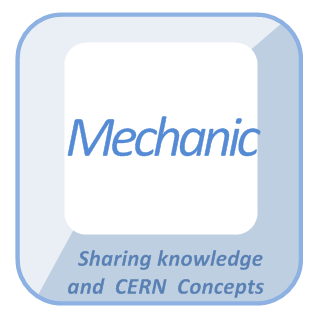|
Converter-Concepts / Mechanical |

|
 |
|
 |
|
 |
CERN
|
SY
|
SY-EPC
|
EDMS
|
PROJECTS
|
ODF
/
OOXML
|
|
CERN
|
SY
|
SY-EPC
|
EDMS
|
PROJECTS
|
ODF
/
OOXML
|

|
|

|
|||||||||||||||||||||||||||||||||||||||||||||||||||||||||||||||||||||||||||||||||||||||||||||||
| Material | Type | Treatment | |
|---|---|---|---|
| Copper | C101/CW004A (ETP) Purity 99.9 % |
Tin Plating - Matte (mandatory) Thickness > 12 µm | |
| Silver Plating Thickness > 12 µm | |||
| Nickel plating Thickness > 12 µm | |||
| Aluminium | 5xxx family : 5754-H111 |
|
6xxx family: 6082-T6 |
| Steel | Mild Steel (Low Carbon Steel) |
Zinc Hot-dip galvanization Thickness > 50 µm | |
| Nickel plating Thickness > 10 µm | |||
| Stainless Steel | 3xx Family: | 316L | Not required |
| 304L | |||
More information available here: "Material types and treatments for standard mechanical parts design", EDMS N° 1909061.
 Treatment
Treatment
Aluminium treatments
Aluminium electrical-conductive treatment
A specific treatment of all aluminium plates and pieces used in power module case conception is required to ensure a good electrical conductivity. This electrical conductivity is a key point for EMC purposes, since power module case is used for equipotential purpose.
SY-EPC-LPC recommended treatment
Process
Characteristic
Conformity
Deposition
Thickness
Compatible Environment
Conductivity
Color
Standards
SURTEC 650
Immersion, spray, wipe (paint)
> 110mg/m²
90% humidity
[-20°C..+85°C]
no salt
< 5 mOhms/inch²
< 0.77 mOhms/cm²
Detectable (blue) C or V-option
ROHS, MIL-DTL-81706B
A specific treatment of all aluminium plates and pieces used in power module case conception is required to ensure a good electrical conductivity. This electrical conductivity is a key point for EMC purposes, since power module case is used for equipotential purpose.
| SY-EPC-LPC recommended treatment | Process | Characteristic | Conformity | |||
|---|---|---|---|---|---|---|
| Deposition | Thickness | Compatible Environment | Conductivity | Color | Standards | |
| SURTEC 650 | Immersion, spray, wipe (paint) | > 110mg/m² | 90% humidity [-20°C..+85°C] no salt |
< 5 mOhms/inch² < 0.77 mOhms/cm² |
Detectable (blue) C or V-option | ROHS, MIL-DTL-81706B |
Recommended treatment, (possible alternative not fully qualified)
Aluminium Non electrical-conductive treatment
Standard treatment like anodisation process is commonly used.
Steel treatment
Steel electrical-conductive treatment
A specific treatment of all steel plates and pieces used in power module case conception is required to ensure a good electrical conductivity. This electrical conductivity is a key point for EMC purposes, since power module case is used for equipotential purpose. It could be noticed that time often reduces surface contact quality (passivation for inox, copper oxidation, or even dust for metal).
| SY-EPC-LPC recommended treatment | Process | Characteristic | Conformity | |||
|---|---|---|---|---|---|---|
| Deposition | Thickness | Compatible Environment | Conductivity | Color | Standards | |
| Zinc galvanization | Electrolize | > 50 µm | 90% humidity, [-20°C..+85°C], no salt | < 60 mOhms/inch² < 09 mOhms/cm² |
Metal grey look | ASTM A123 |
Summary of treatment
Steel Non electrical-conductive treatment
Standard treatment like epoxy power paint process is commonly used.
 Tin Whiskers
Tin Whiskers
This phenomenon occurs on tin-plated copper after an undefined period, and the factors that contribute to its appearance include the use of pure tin, humidity, temperature variation cycles, and mechanical stress. Please read this document on the subject: EDMS 1909061.
| Mitigation Type | Effectiveness | Applicable parts size | EPC guideline |
|---|---|---|---|
| Tin plating thickness > 12µm | Mitigation | All | Mandatory |
| Tin plating matte finishing | Mitigation | All | Mandatory |
| Blocking material / Increased gap between polarities (> 12mm) | 100% | All | Mandatory |
| Silver plating instead tin plating > 12µm | 100% | Little parts | If possible |
| Pression reduction by fastening torque | Mitigation | All | Mandatory |
| Nickel underlayer of 2µm | Mitigation | All | Optional |
Tin whiskers mitigation measures.
| TOP | CHARTE | HTML | CSS | Ver : 04-03-2024 08:11:15 | Webmaster : Michel GEORGES. |